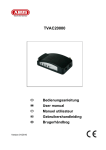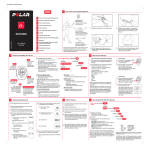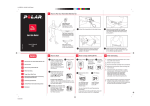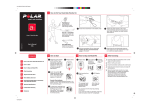Download user manual käyttöohje bruksanvisning brugerhåndbog
Transcript
USER MANUAL KÄYTTÖOHJE BRUKSANVISNING BRUGERHÅNDBOG BRUKSANVISNING Manufactured by Polar Electro Oy Professorintie 5 FIN-90440 KEMPELE Tel +358 8 5202 100 Fax +358 8 5202 300 www.polar.fi 17922831.00 ENG/FIN/SWE/DNK/NOR C F1/F2 Heart Rate Monitor F1/F2-sykemittari F1/F2 hjärtfrekvensmätare F1/F2 pulsmåler F1/F2 hjertefrekvensmåler ENGLISH ................................................3 SUOMI .................................................20 SVENSK................................................37 DANSK .................................................54 NORSK .................................................71 F1 F2 Congratulations on your purchase of a new Polar heart rate monitor! The Polar F1/F2 heart rate monitor is an easy-to-use, entry-level heart rate monitor that is ideal for many reasons: • Prompts you to exercise at least 30 minutes per day • Shows your heart rate and elapsed time during exercise • Enables you to check your average heart rate and total time after each session • Large easy-to-read display • Compact design • One-button functionality “Recommendations from experts agree that for better health, physical activity should be preformed regularly. The most recent recommendations advise people of all ages to include a minimum of 30 minutes of physical activity of moderate intensity (such as brisk walking) on most, if not all, days of the week. It is also acknowledged that for most people, greater health benefits can be obtained by engaging in physical activity of more vigorous intensity or of longer duration.” U.S. Department of Health and Human Services. Physical Activity and Health: A Report of the Surgeon General. Atlanta, GA: U.S. Department of Health and Human Services, Centers for Disease Control and Prevention, National Center for Chronic Disease Prevention and Health Promotion, 1996; 2:6. Why should you use a heart rate monitor? • Training at your own ideal pace is made possible with a heart rate monitor. • The ability to monitor and measure your progress motivates you. • A heart rate monitor maximizes the benefits of exercise in a limited amount of time. • A heart rate monitor provides you with objective information. Are you on the right track? Are you improving? • A heart rate monitor provides you with immediate feedback; this is why it is an ideal training partner for you! The Polar F1/F2 heart rate monitor is a reliable and convenient way to measure your heart rate. It is as accurate as using an electrocardiogram (ECG). You can use the wrist unit to conveniently view your heart rate while walking, swimming, cross-country skiing, or any other exercise without disturbing your exercise rhythm. In addition professional athletes and amateurs alike have relied on the information provided by their heart rate monitor for decades, so why shouldn’t you? Read on to find out how to get the best benefit of your new training buddy! ENGLISH 3 TABLE OF CONTENTS Information specific to the F2 product only is marked in gray. 1. INTRODUCTION TO THE F1 AND F2 HEART RATE MONITORS ....................................................... 5 1.1 HEART RATE MONITOR ELEMENTS .................................................................................................................. 5 1.2 WRIST UNIT SIDE BUTTON AND DISPLAY SYMBOLS ......................................................................................... 6 2. HOW TO ACTIVATE YOUR HEART RATE MONITOR FOR THE FIRST TIME ....................................... 7 2.1 MEASURING YOUR HEART RATE ...................................................................................................................... 8 2.2 HOW TO STOP AND REVIEW A FILE .................................................................................................................. 9 2.3 HOW TO REVIEW YOUR PREVIOUS EXERCISE FILE .......................................................................................... 9 3. 4. 5. 6. HOW TO SET TARGET HEART RATE LIMITS IN F2 ....................................................................... 10 TARGET HEART RATE ZONE ....................................................................................................... 12 CARE AND MAINTENANCE ......................................................................................................... 13 PRECAUTIONS .......................................................................................................................... 14 6.1 POLAR HEART RATE MONITOR AND INTERFERENCE ...................................................................................... 14 6.2 MINIMIZING POSSIBLE RISKS WHEN EXERCISING WITH YOUR HEART RATE MONITOR ................................... 15 7. 8. 9. 10. 4 FREQUENTLY ASKED QUESTIONS .............................................................................................. 16 TECHNICAL SPECIFICATIONS ................................................................................................... 17 LIMITED POLAR INTERNATIONAL GUARANTEE ........................................................................... 18 DISCLAIMER ............................................................................................................................. 19 ENGLISH 1. INTRODUCTION TO THE F1 AND F2 HEART RATE MONITORS The following chapter contains information on the elements of the F1/F2 heart rate monitors and how to get started. 1.1 HEART RATE MONITOR ELEMENTS Wrist Unit The wrist unit allows you to monitor your heart rate and exercise time. You can set target heart rate limits for yourself, which you can monitor while exercising. The target heart rate alarm sounds or the reading flashes if you exercise outside the limits. Transmitter Wear the transmitter while exercising as the transmitter detects and transmits your heart rate to the wrist unit. The electrode areas are on the back of the transmitter. Elastic Strap The elastic strap holds the transmitter in place around your chest. ENGLISH 5 1.2 WRIST UNIT SIDE BUTTON AND DISPLAY SYMBOLS This section contains information on how to operate the wrist unit and a symbols guide for reading the data on the display. Polar F1 and F2 heart rate monitors have one operating side button. Side button functions: • Start heart rate measurement. • Start and stop the stopwatch. • Activate the functions shown on the display. • Check your previous exercise file. • Set the target heart rate limits. Heart Touch Bring the wrist unit near the Polar logo on the transmitter and your elapsed exercise time will appear for six seconds. Display symbols Avg Indicates that the average heart rate value is on the display. This figure, expressed in beats per minute (bpm), represents the average heart rate measured over a specific period of time (for instance, during an exercise session). Total Indicates that the total exercise time is on the display. Exercise Time Indicator The indicator has six different bullets; each represents 10 minutes. One cycle of bullets takes 60 minutes. When all the bullets are filled in, the cycle starts again. Fill in just three bullets a day, and you will see some health benefits. Heart Symbol Indicates your heart rate is being measured. Target Heart Rate Alarm Indicates when the target heart rate alarm is on in the SET and EXERCISE modes. 6 ENGLISH 2. HOW TO ACTIVATE YOUR HEART RATE MONITOR FOR THE FIRST TIME This chapter contains information on how to start to use your heart rate monitor for the first time and how to wear the transmitter. Before you start exercising, we recommend that you read about target heart rate zones on page 12. This information will help you exercise at the right level. After determining your target heart rate limits, you can go to page 10, which contains instructions on how to set your F2 wrist unit. Transmitter 3. Lift the transmitter off your chest and moisten the two grooved electrode areas on the back. Check that the wet electrode areas are firmly against your skin and that the Polar logo is in a central, upright position. 4. Wear the wrist unit as a watch and press the side button to start monitoring your exercise. For further information on measuring your heart rate, see the following page. 1. Attach one end of the transmitter to the elastic strap. 2. Adjust the strap length to fit snugly and comfortably. Secure the strap around your chest, just below the chest muscles, and attach the strap to the other end of the transmitter. ENGLISH 7 2.1 MEASURING YOUR HEART RATE 1. Press the side button to start. Keep a minimum of 3 feet/1 meter away from other heart rate monitor users until the heart rate symbol appears and flashes evenly. 2. The stopwatch starts. Your heart rate appears in six seconds. The heart rate symbol flashes in time with the beat of your heart. Before the stopwatch starts, the target heart rate limits, that will be used while you exercise, are shown once on the display. The target heart rate alarm symbol is shown provided that you have switched it on. 8 ENGLISH Exercise Time Indicator 1 bullet = 10 minutes of exercise, 6 bullets = 1 hour of exercise. After one hour, when all the bullets are filled in, the cycle starts again. After 9 hour 59 minutes of exercise the wrist unit returns to the OFF mode. To start measuring your heart rate again, press the side button. This deletes the previous file. 3. To check your exercise time while exercising bring the wrist unit up to the Polar logo on the transmitter. Your elapsed exercise time appears for six seconds. If the wrist unit does not detect your heart rate signal, 00 appears on the display as your heart rate value. If there is no heart rate signal for more than five minutes, the receiver automatically returns to the OFF mode. 2.2 HOW TO STOP AND REVIEW A FILE 2.3 HOW TO REVIEW YOUR PREVIOUS EXERCISE FILE 1. Press the side button to stop recording the exercise. 1. In the OFF mode, press and hold the side button until FILE appears on the display. Release the side button. FILE and SET flash alternatively. When FILE is on the display, press the side button to enter the FILE mode. 2. The file review starts and the average heart rate (AVG) and total exercise time (TOTAL) flash alternatively three times for 3 seconds each. 2. The file shows your previous average heart rate and total exercise time. They flash alternatively three times and then the wrist unit returns to the OFF mode. 3. The wrist unit returns automatically to the OFF mode. To stop reviewing the file at any time, press the side button. Note: Information on your previous exercise file is saved until you start recording a new exercise session. At this point, the new information replaces the old. Note: If you accidentally press the side button and the stopwatch starts running, you have one minute to stop it and save your previous exercise file. ENGLISH 9 3. HOW TO SET TARGET HEART RATE LIMITS IN F2 Before exercising, it is recommended that you set your target heart rate limits and alarm. This way you can make sure that you are exercising at your desired intensity level (light, moderate or heavy). For further information on determining your personal target heart rate limits, see page 12. If you miss a setting, let the settings scroll to the end and you can start specifying the settings again from step 1. Alternatively you can press and hold the side button at any time until the display returns to the OFF mode. You can start specifying the settings again from step 1. HI = High limit LO = Low limit Ok = Time out, 3 seconds; acceptance of the limit you have set BEEP = target heart rate alarm on/off 1. In the OFF mode, press and hold the side button until FILE appears on the display. Release the side button. 10 ENGLISH 2. When SET is on the display (SET and FILE flash alternatively), press side button to enter SET mode. 3. HI appears briefly on the display, followed by the high limit reading (default 160). Press the side button to change the high limit. The limit can be set in five beat steps. Press the side button until you reach the desired limit and wait for three seconds to approve your choice. Ok appears on the display. 4. LO appears briefly on the display, followed by the low limit reading (default 80). Press the side button to change the low limit. The limit can be set in five beat steps. Press the side button until you reach the desired limit and wait for three seconds to approve your choice. Ok appears on the display. You have completed your target heart rate limits. (The lower limit cannot be set above the upper limit.) Beep appears briefly on the display. You have two alternatives: to switch the target heart rate alarm On or OFF. 6. Target Heart Rate Alarm OFF If you want to switch the alarm from On to OFF press the side button when On is flashing on the display. OFF starts flashing. To switch the alarm OFF, wait for three seconds. Ok appears. The receiver returns to the OFF mode. You have completed your settings. Note: If you want to change one of the limits quickly, repeat steps 1 - 3, but instead of waiting for three seconds to approve your choice, press and hold the side button. The receiver returns to the OFF mode. 5. Target Heart Rate Alarm On On flashes on the display. To switch the alarm On, wait for three seconds. Ok appears and the receiver returns to the OFF mode. ENGLISH 11 4. TARGET HEART RATE ZONE You should always start exercising slowly at a light intensity and gradually increase the intensity of your exercise to raise your heart rate. When you set your target heart rate zone, you do not have to worry about exercising at too high on intensity. This way you know that you are exercising safely. To find your maximum heart rate, you can use the age formula, HRmax = 220 - age. Your target heart rate zone is a percentage level of your HRmax. (HRmax = The highest number of heartbeats per minute (bpm) during maximum physical exertion.) When your heart beats at 50 - 60% of your HRmax, you are in the light intensity zone. This includes easy exercises like daily activities and light chores. The light intensity zone delivers some health benefits. Push on to 60 - 70% of your HRmax and you are in the light to moderate intensity zone. This is good for improving health, fitness, and for weight loss. It also improves endurance. At 70 - 85% of your HRmax, you have moved into the moderate to heavy intensity zone. This is harder work, but effective for strengthening aerobic fitness and endurance, especially for people exercising more regularly. 12 ENGLISH For a more accurate measurement of your HRmax visit your doctor or exercise physiologist for an exercise stress test. The following table shows target heart rate zones in bpm estimated by age. Calculate and write down your own HRmax and determine your individual intensity zone(s) for your maximum benefit. When you exercise in the right intensity zone, it guarantees your enjoyment when you participate in your favorite sports. Remember to alternate between intensity zones to improve your fitness! Age HRmax (220 - age) Light intensity Light to moderate intensity Moderate to heavy intensity 20 25 30 35 40 45 50 55 60 65 200 195 190 185 180 175 170 165 160 155 100 - 120 97 - 117 95 - 114 92 - 111 90 - 108 87 - 105 85 - 102 82 - 99 80 - 96 77 - 93 120 - 140 117 - 136 114 - 133 111 - 129 108 - 126 105 - 122 102 - 119 99 - 115 96 - 112 93 - 108 140 - 170 136 - 165 133 - 161 129 - 157 126 - 153 122 - 148 119 - 144 115 - 140 112 - 136 108 - 131 Write down your own HRmax and intensity zones. 5. CARE AND MAINTENANCE Your Polar heart rate monitor is a high-tech instrument and should be treated with care. The suggestions below will help you fulfill the guarantee obligations and enjoy the product for many years to come. Taking Care of Your Polar Heart Rate Monitor • Clean the transmitter regularly after use with a mild soap and water solution. Dry it carefully with a soft towel. • Never store the transmitter wet. Sweat and moisture can keep its electrodes wet and the transmitter activated, which shortens the battery lifespan. • Store your heart rate monitor in a cool and dry place. Do not store it in any kind of non-breathing material, such as a plastic bag or a sports bag if it is wet. • Do not bend or stretch the transmitter. This may damage the electrodes. • Do not dry the transmitter in any other way than with a towel. Mishandling may damage the electrodes. • Keep your heart rate monitor out of extreme cold and heat. The operating temperature is 14˚F to 122˚F / -10˚C to +50˚C. • Do not expose the heart rate monitor to direct sunlight for extended periods, such as by leaving it in a car. Transmitter Batteries The estimated average battery lifespan of the transmitter is 2500 hours of use. Contact your authorized Polar Service Center for a replacement transmitter. See your Customer Care and Registration Card for detailed instructions. Receiver Batteries The estimated average battery lifespan of the wrist unit is 2 years of normal use (2h/day, 7 days a week). Do not open the wrist unit yourself. To ensure the water resistance properties and the use of authorized components, the wrist unit battery should be replaced by an authorized Polar Service Center only. At the same time a full periodic check of the Polar heart rate monitor will be done. Service Should your Polar heart rate monitor need service, see your Customer Care and Registration Card to contact an authorized Polar Service Center. Water resistance cannot be guaranteed after unauthorized service. ENGLISH 13 6. PRECAUTIONS 6.1 POLAR HEART RATE MONITOR AND INTERFERENCE Electromagnetic Interference Interference may occur near high voltage power lines, traffic lights, overhead lines of electric railways, electric bus lines or trams, televisions, car motors, bike computers, some motor driven exercise equipment, cellular phones or when you walk through electric security gates. Exercise Equipment Several pieces of exercise equipment with electronic or electrical components such as LED displays, motors, and electric brakes may cause interference with stray signals. To try to solve the problem, relocate your wrist unit as follows: 1. Remove the transmitter from your chest and use the exercise equipment as you would normally. 2. Move the wrist unit around until you find an area where it displays no stray reading or the heart symbol does not flash. Interference is often worst right in front of the display panel of the equipment, while the left or right side of the display is relatively free of interference. 3. Put the transmitter back on your chest and keep your wrist receiver in this interference-free area as far as it is possible. Note: If the Polar heart rate monitor still does not work with the exercise equipment, this piece of equipment may be electrically too noisy for wireless heart rate measurement. 14 ENGLISH Crosstalk The F1 and F2 heart rate monitors are non-coded and pick up transmitter signals within 3 feet/1 meter. Other non-coded signals, picked up simultaneously from more than one transmitter, can cause incorrect readouts. Using Your Polar Heart Rate Monitor in Water Your Polar heart rate monitor is water resistant to 100 feet/30 meters. To maintain the water resistance, do not press the side button of the wrist unit under water. Users measuring their heart rate in water may experience interference for the following reasons: • Pool water with a high chlorine content and seawater are very conductive. The electrodes of a Polar transmitter may short circuit, which prevents the transmitter unit from detecting ECG signals. • Jumping into water or strenuous muscle movement during competitive swimming may cause water resistance that shifts the transmitter on the body to a location where it is not possible to pick up an ECG signal. • ECG signal strength is individual and also varies depending on an individual's tissue composition. The percentage of people who have problems measuring their heart rate is considerably higher in water than in other environments. 6.2 MINIMIZING POSSIBLE RISKS WHEN EXERCISING WITH YOUR HEART RATE MONITOR Exercise may include some risk, especially for those who have been sedentary. Before starting a regular exercise program, it is recommended that you answer the following questions about your health status. If your answer yes to any of the questions below, we recommend that you consult a doctor before starting an exercise program. • Have you not exercised for the past 5 years? • Do you have high blood pressure? • Do you have high blood cholesterol? • Do you have symptoms of any disease? • Are you taking any blood pressure or heart medication? • Do you have a history of breathing problems? • Are you recovering from a serious illness or medical treatment? • Do you use a pacemaker or another implanted electronic device? • Do you smoke? • Are you pregnant? It is important to be sensitive to your body’s reactions during exercise. If you feel unexpected pain or excessive fatigue when exercising, it is recommended that you stop the exercise or continue at a lighter intensity. Notice to persons with pacemakers, defibrillators or other implanted electronic devices. Individuals who have a pacemaker use the Polar heart rate monitor at their own risk. Before use, we always recommend an exercise test under a doctor’s supervision. The test is to ensure the safety and reliability of the simultaneous use of the pacemaker and the heart rate monitor. If you are allergic to any substance that comes into contact with your skin or if you suspect an allergic reaction due to using the product, check the listed materials in the Technical Specifications chapter on page 17. To avoid any skin reaction risk with the transmitter, wear it over a shirt. However, moisten the shirt well under the electrodes to ensure flawless operation. Note: The combined impact of moisture and intense abrasion may cause a black color to rub off the transmitter’s surface, which might stain light-colored clothes. Note that in addition to exercise intensity, medications for heart problems, blood pressure, psychiatric conditions, asthma, breathing etc. as well as some energy drinks, alcohol, and nicotine can affect heart rate. ENGLISH 15 7. FREQUENTLY ASKED QUESTIONS What should I do if... ...there is no heart rate reading (00)? 1. Check that the electrodes of the transmitter are moistened and that you are wearing it as instructed. 2. Check that you have kept the transmitter clean. 3. Check that there are no sources of electromagnetic radiation in close vicinity to the Polar wrist unit, such as TV sets, cellular phones, CRT monitors, etc. 4. Have you had a cardiac event that may have altered your ECG waveform? In this case, consult your physician. ...heart symbol flashes irregularly? 1. Check that your wrist unit is inside the transmission range and not further that 3 feet/1 meter from the Polar transmitter you are wearing. 2. Check that the elastic strap has not become loose during exercise. 3. Make sure that the electrodes of the transmitter are moistened. 4. Make sure that there is no other heart rate transmitter within the reception range (3 feet/1 meter). 5. Cardiac arrhythmia may cause irregular readings. In this case, consult your physician. 16 ENGLISH ...heart rate reading becomes erratic or extremely high? You may have come within range of strong electromagnetic signals, which can cause erratic readings on the wrist unit display. Check your surroundings and move further away from the source of the disturbance. ...the wrist unit battery needs changing? We recommend that all service be done by an authorized Polar Service Center. The 2-year International Guarantee/Warranty does not cover damage or consequential damage caused by service not authorized by Polar Electro. Polar Service Center will test your wrist unit for water resistance after battery replacement and makes a full periodic check of your complete Polar F1/F2 heart rate monitor. 8. TECHNICAL SPECIFICATIONS The F1/F2 heart rate monitor is designed to • to help the users to achieve their personal fitness goals. • to indicate the level of physiological strain and intensity during an exercise session. No other use is intended or implied. Heart rate is displayed as number of heartbeats per minute (bpm). Total exercise time: Exercise time display < 1 h: Exercise time display > 1 h: Minimum duration of recorded exercise: Heart rate limits: Wrist Unit Battery type: Battery life: Polar Transmitter Battery type: Battery life: Operating temperature: CR 2025 average 2 years (2h/day, 7 days/week) Operating temperature: 14 °F to 122 °F/ -10 °C to +50 °C Water resistance: up to 100 feet/ 30 meters Wrist Strap and Strap Loop: Thermoplastic Polyurethane (TPU) Wrist Strap Buckle and Strap Tongue: Polyoxymethylene (POM) Back cover material: Stainless steel complying with the nickel release regulations of the EU (EU Directive 94/27/EU and its amendment 1999/C 205/05). Accuracy of heart rate measurement: ± 1% or ± 1 bpm, whichever larger, definition applies to steady state conditions Material: Water resistance: Elastic Strap Buckle material: Fabric material: 9 h 59 min mm:ss hh:mm 1 min 30 - 195 bpm Built-in Lithium Cell Average 2500 hours of use 14 °F to 122 °F/ -10 °C to +50 °C Polyurethane Waterproof Polyurethane Nylon, polyester, and natural rubber including a small amount of latex ENGLISH 17 9. LIMITED POLAR INTERNATIONAL GUARANTEE • This limited Polar international guarantee is issued by Polar Electro Inc. for the consumers who have purchased this product in the USA or Canada. This limited Polar international guarantee is issued by Polar Electro Oy for the consumers who have purchased this product in other countries. • Polar Electro Inc. / Polar Electro Oy guarantees to the original consumer / purchaser of this product that the product will be free from defects in material or workmanship for two years from the date of purchase. • Please keep the receipt or International Guarantee Card, which is your proof of purchase! • The guarantee does not cover the battery, damage due to misuse, abuse, accidents or non-compliance with the precautions; improper maintenance, commercial use, cracked or broken cases. • Guarantee does not cover any damage/s, losses, costs or expenses, direct, indirect or incidental, consequential or special, arising out of, or related to the product. During the guarantee period the product will be either repaired or replaced at an authorized service center free of charge. • This guarantee does not affect the consumer’s statutory rights under applicable national or state laws in force, or the consumer’s rights against the dealer arising from their sales/ purchase contract. 18 ENGLISH This CE marking shows compliance of this product with Directive 93/42/EEC. Polar Electro Oy is a ISO 9001:2000 certified company. Copyright © 2003-2004 Polar Electro Oy, 90440 Kempele, Finland. All rights reserved. No part of this manual may be used or reproduced in any form or by any means without prior written permission of Polar Electro Oy. The names and logos marked with a ™ symbol in this user manual or in the package of this product are trademarks of Polar Electro Oy. The names and logos marked with a ® symbol in this user manual or in the package of this product are registered trademarks of Polar Electro Oy. 10. DISCLAIMER • The material in this manual is for informational purposes only. The products it describes are subject to change without prior notice, due to the manufacturer’s continuous development program. • Polar Electro Oy makes no representations or warranties with respect to this manual or with respect to the products described herein. Polar Electro Oy shall not be liable for any damages, direct or incidental, consequential or special, arising out of, or related to the use of this material or the products described herein. This product is protected by one or several of the following patents: FI 88223, DE 4215549, FR 92.06120, GB 2257523, HK 113/1996, SG 9591671-4, US 5491474, FI 88972, DE 9219139.8, FR 92.09150, GB 2258587, HK 306/1996, SG 9592117-7, US 5486818, FI 96380, US 5611346, EP 665947, DE 69414362, FI 68734, DE 3439238, GB 2149514, HK 812/1989, US 4625733, FI 100924, FI 100452, US 5840039, FI 4150, DE 20008882.3, FR 0006504, FI 4069, US 6272365, FR 9907823, GB 2339833, DE 29910633, FI 104463, US 6183422, FI 4157, DE 20008883.1, FR 0006778, WO 97/33512, GB 2326240. Other patents pending. ENGLISH 19































